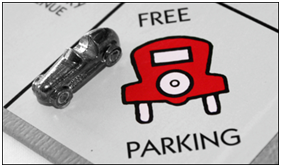John Barrier had done business with Old National Bank in Spokane for 30 years. He made his income buying and refurbishing old buildings, so he wore everyday work clothes that October day in 1988. He left his pickup truck in a nearby parking lot while he paid a visit to his broker, and then ducked into the bank to cash a check. The teller, however, took one look at his grubby clothes, quickly cashed the check but refused to stamp his parking ticket.
 She told Barrier that the bank only validated parking when a customer made a transaction and cashing a check didn’t count. The millionaire was a bit agitated, and asked the teller to call one of the bank managers. She did, but he also refused Barrier’s request.
She told Barrier that the bank only validated parking when a customer made a transaction and cashing a check didn’t count. The millionaire was a bit agitated, and asked the teller to call one of the bank managers. She did, but he also refused Barrier’s request.
“He looked me up and down and gave me one of those looks,” said Barrier, turning up his nose to imitate the manager.Barrier then said, “Fine, it’s obvious you don’t need me so I guess I don’t need you either.” He made a formal request to close his account, and this was the first time ONB realized Barrier was one of their biggest customers! He requested a cashier’s check and proceeded down the street to Seafirst Bank.
“The check he brought me from Old National was for a little over $1 million,” said Dennis Veter, Seafirst vice president. “You’d never know by looking at him that he was wealthy, but regardless, I felt very lucky.”
Barrier said, “Whether you have $1 or $1 million, I think they owe every customer the courtesy of stamping your parking ticket.” I’ll bet Mr. Barrier never had trouble with parking validation after that day.
Interestingly, one year before Mr. Barrier’s encounter, Michael LeBeouf wrote and published the initial version of his widely-read book, How to Win Customers and Keep Them for Life. In the most recent edition of his classic, updated a few years ago, he cites some statistics that should scare all sales and customer service reps spitless! Listen to these:
1. A typical business hears from only 4 percent of its dissatisfied customers. The other 96% just quietly go away and 91% never come back.That represents a serious financial loss for companies whose people don’t know how to treat customers, and a tremendous gain to those that do.
2. A recent survey on “Why customers quit” found the following:
- 3% Move away
- 5% Develop other vendor friendships
- 9% Leave for competitive reasons
- 14% Dissatisfied with the product or service
- 68% Quit because of an attitude of indifference toward the customer by the owner, manager, sales or service employee.
That tells me that I can start a company that sells what you sell, and by paying attention and treating people special, I can take away 2/3 of your customers in a relatively short period of time.
3. A typical dissatisfied customer will tell 8-10 people about the problem. One in 5 will tell 20 others. That said, it takes 12 positive service incidents to make up for 1 negative incident.
 4. Seven out of 10 complaining customers will do business with you again if you resolve the complaint in their favor. If you resolve it on the spot 95% will do business with you again. On average, a satisfied complainer will tell 5 people about the problem and how it was satisfactorily resolved.
4. Seven out of 10 complaining customers will do business with you again if you resolve the complaint in their favor. If you resolve it on the spot 95% will do business with you again. On average, a satisfied complainer will tell 5 people about the problem and how it was satisfactorily resolved.
5. The average business spends 6 times more to attract new customers than it does to keep old ones. Yet customer loyalty is in most cases worth 10 times the price of a single purchase.
6. Businesses having a low service quality average only a 1% return onsales and lose market share at the rate of 2% per year. Businesses with high service quality average a 12% return on sales, gain market share at the rate of 6% per year, and charge significantly higher prices. Many businesses experiencing this problem go about attacking it incorrectly. They think that if their return on sales if too slim the answer is to get a bigger truck!
7. A typical corporation loses half of its customers every 5 years. Yet by increasing the yearly customer retention rate by as little as 5%, companies can increase their bottom line profits from 25 to 100%. If you were to break that down further, you would see that losing half your customers every 5 years, it’s like having a hole in a bucket that drips 1% every month!
Does your company have a team of technicians, installers, or service specialists that should be upselling collateral services and products as well as adding new customers? Are they failing to do this because they are either scared or haven’t learned the face-to-face skills necessary for this part of their job description? Doug can help with this dilemma since he specializes in helping blue collar employees in sales-related situations. Look at his inexpensive solutions for your company right here.
©2015 Robinson Training Solutions, LLC


